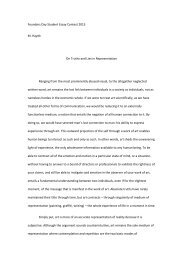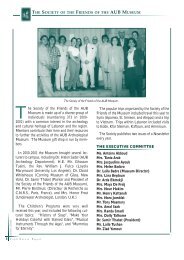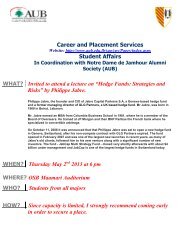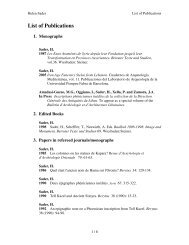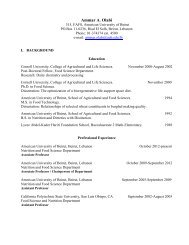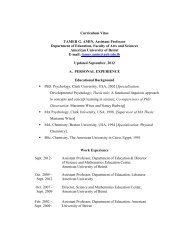The IX t h Makassed Medical Congress - American University of Beirut
The IX t h Makassed Medical Congress - American University of Beirut
The IX t h Makassed Medical Congress - American University of Beirut
You also want an ePaper? Increase the reach of your titles
YUMPU automatically turns print PDFs into web optimized ePapers that Google loves.
470 Valvular, Myocardial, Pericardial, and Cardiopulmonary Disease<br />
Outcomes<br />
is crossed antegradely, dilated, and then stented under rapid pacing as in<br />
the transfemoral route, except that the Edwards Sapien valve is mounted<br />
appropriately with its sleeve on the ventricular side <strong>of</strong> the valve.<br />
• <strong>The</strong> transseptal approach (Fig. 1C) is somewhat more challenging for<br />
an interventionalist who may not be accustomed to working in the left<br />
atrium. <strong>The</strong>re is some danger <strong>of</strong> damaging the mitral valve with the stiff<br />
wire if adequate slack is not maintained during the procedure. Femoral<br />
venous access is obtained and a balloon-tipped catheter advanced<br />
into the left ventricle after transeptal puncture. <strong>The</strong> aortic valve is then<br />
crossed with a wire or the catheter itself. <strong>The</strong> wire is then snared via<br />
femoral arterial access, and a catheter is passed to the aortic valve for<br />
adequate control <strong>of</strong> the wire. Valvuloplasty and valve replacement steps<br />
are similar to those <strong>of</strong> other approaches.<br />
• Percutaneous AVR was fi rst performed via transseptal access by<br />
Dr. Allan Cribier in Rouen, France in April 2002. <strong>The</strong> initial experience<br />
from compassionate use <strong>of</strong> the balloon-expandable 23-mm valve<br />
from the antegrade approach was reported in the I-REVIVE (Initial<br />
Registry <strong>of</strong> Endovascular Implantation <strong>of</strong> Valves in Europe) and<br />
RECAST (Registry <strong>of</strong> Endovascular Critical Aortic Stenosis Treatment).<br />
<strong>The</strong> procedural success rate was 75%, with a 30-day mortality<br />
rate <strong>of</strong> 23%. Moderate to severe aortic regurgitation was reported<br />
in 63% <strong>of</strong> patients, partly as a result <strong>of</strong> the valve size. Concerns also<br />
were raised about the procedural challenges posed by the transseptal<br />
puncture and the potential for damage to the mitral valve apparatus<br />
by the stiff wire and aortic prosthesis.<br />
• Signifi cant advances were made by Dr. John Webb in Vancouver in<br />
implanting this valve retrogradely via the transfemoral route. His team<br />
successfully implanted the Cribier-Edwards valve in 14 <strong>of</strong> 18 patients<br />
who had previously been deemed unsuitable for SAVR [16]. <strong>The</strong> measured<br />
aortic valve area increased from 0.6 ± 0.2 to 1.6 ± 0.4 cm 2 and<br />
remained stable at 1-month follow-up [16]. <strong>The</strong> early mortality rate<br />
was 11% (2 <strong>of</strong> 18), and short-term survival was 89% (16 <strong>of</strong> 18) at a<br />
mean follow-up <strong>of</strong> 75 days [16]. <strong>The</strong> same group reported both short-<br />
and long-term outcomes in an extended cohort <strong>of</strong> 50 patients [24••].<br />
Procedural success increased from 76% in the fi rst 25 patients to 96%<br />
in the second [25], and 30-day mortality fell from 16% to 8%. Further,<br />
this series demonstrated that paravalvular leak is not a major issue if<br />
the valve size is larger than the annulus (ie, a 23-mm valve for a 17- to<br />
21-mm annulus and a 26-mm valve for a 21- to 24-mm annulus). It also<br />
was apparent that the success rate was very dependent on proper patient<br />
selection, with the main focus on vascular access to prevent procedural<br />
vascular complications.<br />
• Lichtenstein et al. [25] successfully implanted the Cribier-Edwards valve<br />
using the apical approach and fl uoroscopic guidance in all seven patients<br />
in whom they attempted the procedure. All patients were deemed by<br />
an experienced operator to be unsuitable for SAVR and also for percutaneous<br />
transfemoral percutaneous heart valve implantation because<br />
<strong>of</strong> severe aortoiliac disease [25]. Four <strong>of</strong> the seven patients were alive<br />
at 6 months [26]. Subsequently, Walther et al. [27] published their data<br />
describing implantation <strong>of</strong> the Cribier-Edwards valve in 30 elderly patients.<br />
At a mean follow-up <strong>of</strong> 108 days, 86% <strong>of</strong> the patients reportedly<br />
were doing well [27].<br />
85






